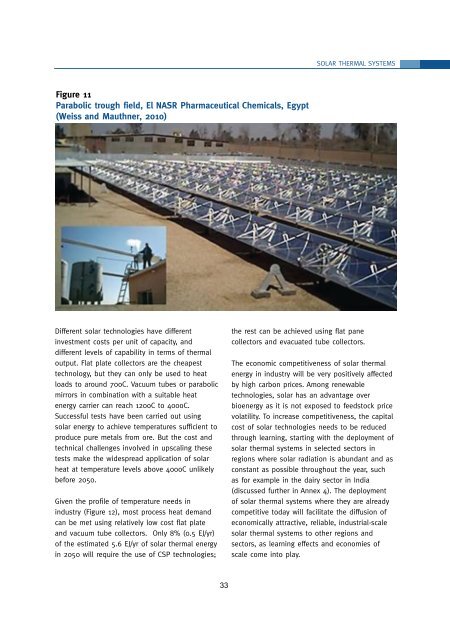Renewable Energy in Industrial Applications â an ... - Unido
Renewable Energy in Industrial Applications â an ... - Unido
Renewable Energy in Industrial Applications â an ... - Unido
You also want an ePaper? Increase the reach of your titles
YUMPU automatically turns print PDFs into web optimized ePapers that Google loves.
SOLAR THERMAL SYSTEMS<br />
Figure 11<br />
Parabolic trough field, El NASR Pharmaceutical Chemicals, Egypt<br />
(Weiss <strong>an</strong>d Mauthner, 2010)<br />
Different solar technologies have different<br />
<strong>in</strong>vestment costs per unit of capacity, <strong>an</strong>d<br />
different levels of capability <strong>in</strong> terms of thermal<br />
output. Flat plate collectors are the cheapest<br />
technology, but they c<strong>an</strong> only be used to heat<br />
loads to around 70oC. Vacuum tubes or parabolic<br />
mirrors <strong>in</strong> comb<strong>in</strong>ation with a suitable heat<br />
energy carrier c<strong>an</strong> reach 120oC to 400oC.<br />
Successful tests have been carried out us<strong>in</strong>g<br />
solar energy to achieve temperatures sufficient to<br />
produce pure metals from ore. But the cost <strong>an</strong>d<br />
technical challenges <strong>in</strong>volved <strong>in</strong> upscal<strong>in</strong>g these<br />
tests make the widespread application of solar<br />
heat at temperature levels above 400oC unlikely<br />
before 2050.<br />
Given the profile of temperature needs <strong>in</strong><br />
<strong>in</strong>dustry (Figure 12), most process heat dem<strong>an</strong>d<br />
c<strong>an</strong> be met us<strong>in</strong>g relatively low cost flat plate<br />
<strong>an</strong>d vacuum tube collectors. Only 8% (0.5 EJ/yr)<br />
of the estimated 5.6 EJ/yr of solar thermal energy<br />
<strong>in</strong> 2050 will require the use of CSP technologies;<br />
the rest c<strong>an</strong> be achieved us<strong>in</strong>g flat p<strong>an</strong>e<br />
collectors <strong>an</strong>d evacuated tube collectors.<br />
The economic competitiveness of solar thermal<br />
energy <strong>in</strong> <strong>in</strong>dustry will be very positively affected<br />
by high carbon prices. Among renewable<br />
technologies, solar has <strong>an</strong> adv<strong>an</strong>tage over<br />
bioenergy as it is not exposed to feedstock price<br />
volatility. To <strong>in</strong>crease competitiveness, the capital<br />
cost of solar technologies needs to be reduced<br />
through learn<strong>in</strong>g, start<strong>in</strong>g with the deployment of<br />
solar thermal systems <strong>in</strong> selected sectors <strong>in</strong><br />
regions where solar radiation is abund<strong>an</strong>t <strong>an</strong>d as<br />
const<strong>an</strong>t as possible throughout the year, such<br />
as for example <strong>in</strong> the dairy sector <strong>in</strong> India<br />
(discussed further <strong>in</strong> Annex 4). The deployment<br />
of solar thermal systems where they are already<br />
competitive today will facilitate the diffusion of<br />
economically attractive, reliable, <strong>in</strong>dustrial-scale<br />
solar thermal systems to other regions <strong>an</strong>d<br />
sectors, as learn<strong>in</strong>g effects <strong>an</strong>d economies of<br />
scale come <strong>in</strong>to play.<br />
33

















